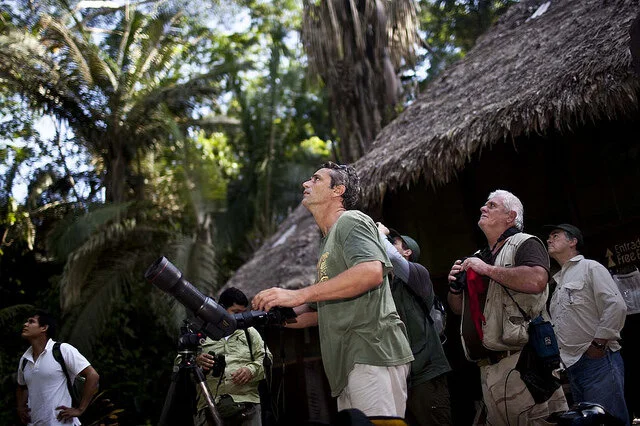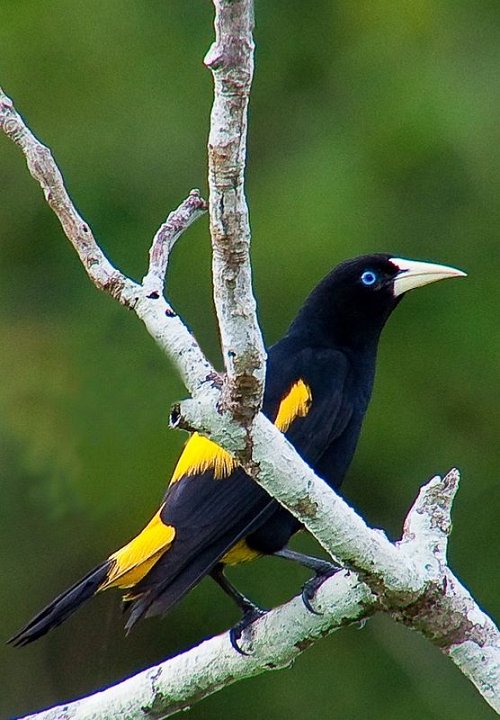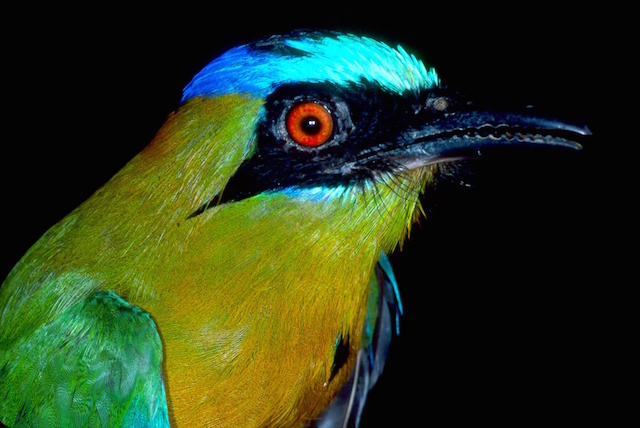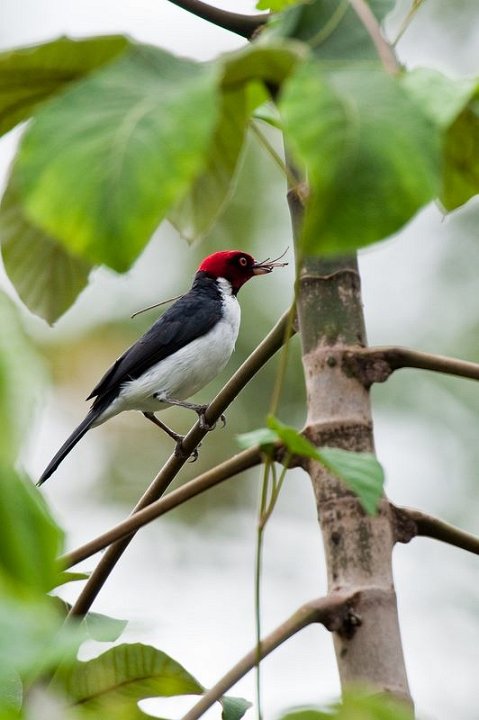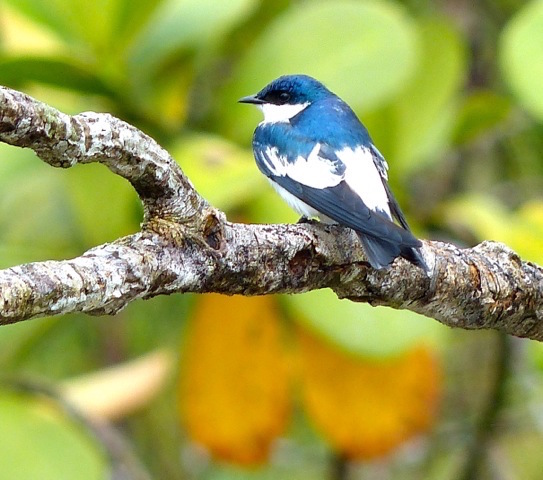Great Northern Peruvian Birding Route 21-Day Tour
3 weeks on Great Northern Peruvian Birding Route, with knowledgeable guides.
From Amazon rain forest to Andean cloud forest: remarkable variety of eco-systems & species.
Bucket list destination for the serious & casual birder alike.
Wonderful scenery & fascinating archaeology along the way.
Overview
Home to at least 1,600 species, including 140 restricted-range species from 10 endemic areas, and 75 globally-threatened species, the Northern Peru Birding Route traverses the Pacific coast, the Andes mountains, and the Amazon basin.
It covers the coastal deserts and the mega-diverse Marañon Valley, lowland rainforest replete with flooded forest and swamps, tropical dry forest, and high montane cloud forest abundant in epiphytic plants and elfin trees.
Great Northern Peruvian Birding Route: 21-Day Itinerary Outline:
Day 1: Arrive Tarapoto. Overnight at Pumarinri Lodge.
Day 2: Huallaga Boat Trip. Overnight at Pumarinri Lodge.
Day 3: Pucayaquillo Waterfall. Overnight at Pumarinri Lodge.
Day 4: Quebrada Upaquihua. Overnight at Pumarinri Lodge.
Day 5: Juan Guerra. Overnight at Tucan Suites.
Day 6: Cerro Escalera. Overnight at Tucan Suites.
Day 7: Ricuricocha birding; Drive to Moyabamba. Overnight at Waqanki or Puerto Mirador.
Day 8: Mishquiyacu. Overnight at Waqanki or Puerto Mirador.
Day 9: Santa Elena & Rio Romero. Overnight at Waqanki or Puerto Mirador.
Day 10: Arena Blanca - Abra Patricia. Overnight at Owlet Lodge.
Day 11. Abra Patricia Birding. Overnight at Owlet Lodge.
Day 12: Abra Patricia Birding; Drive to Gocta. Overnight at Gocta Lodge.
Day 13: Rio Chido Trail & Huembo. Overnight at Gocta Lodge.
Day 14: Gocta Falls (low path). Overnight at Gocta Lodge.
Day 15: Huaylla Belen. Overnight at Gocta Lodge.
Day 16: Kuelap. Overnight at Casa Mallqui, Leymebamba.
Day 17: Rio Atuen Valley. Overnight at Casa Mallqui, Leymebamba.
Day 18: Abra Barra Negro; Upper Marañon. Overnight at Hotel Turistico, Celendin.
Day 19: Drive to Cajamarca. Overnight at Hotel Casona del Inca.
Day 20: Cajamarca Birding. Overnight at Hotel Casona del Inca.
Day 21: Transfer to airport OR drive to Chaparri Reserve.
Dates
2025 group departure information
There are usually only one or two Great Northern Peruvian birding trips planned per year, but private, customised tours can be arranged for any dates.
In 2025 there is a group trip planned on the following dates:
Mon, 19th May - Tue, 10th June
Please note that this itinerary is a couple of days longer than that published; and instead of going from Leymebamba to Cajamarca (via Celendin), you return to Gocta and then go to Chiclayo, via Jaen and Olmos.
NB. For a shorter and more intense version of this tour - missing out Leymebamba & Abra Barro Negro - have a look at our 15-day tour which moves eastwards, from the Pacific Coast, across the Andes, to end up in the Amazon Basin.
Prices
Below prices are per person when sharing a twin/double room. Includes all land transport, lodging, guided excursions and most meals.
NB. Single room available at additional cost.
| Itinerary | Length | Prices From |
|---|---|---|
| 21 Days | £4,158 / $5,300 |
Itinerary
3-Week Northern Birding Route day-by-Day Itinerary:
Day 1: Tarapoto - Pumarinri
Pumarinri Amazon Lodge, beside the Huallaga River.
Arrive Tarapoto in evening.
Transfer by minibus to Pumarinri Amazon Lodge, about a 40-minute journey. Transfers from the airport at any pre-arranged time.
Local birding or sightseeing for anyone arriving in daylight.
Overnight at Pumarinri, a quality lodge with comfortable, spacious en-suite rooms, set on the slopes of the Huallaga River at an altitude of around 230 m (755 ft).
Day 2: Pumarinri: Birding Trails & Boat Trip
This morning is a chance to recover from the journey to get here.
If you are keen, there is good birding - and some amazing poison dart frogs - to be found around the Lodge. There are trails through the dry forest, along the road or by the river.
Boat trip upriver in afternoon and trail on south side of river.
Spotlighting by the Lodge in the evening ... if still awake!
Overnight at Pumarinri Lodge.
Possible birds: Yellow-rumped Cacique, Cinnamon-throated Woodcreeper, Black-fronted Nunbird, Yellow-browed Tody-Flycatcher, Blue-grey, Palm, Turquoise & Paradise Tanagers, honeycreepers, various parrots, White-winged & White-banded Swallows, Drab Water-Tyrant, Black Phoebe, Chestnut-eared Aracari, Green-backed Trogon, Hoatzin, Ladder-tailed Nightjar, Fasciated Tiger-Heron, Pied Lapwing. Evening: Tropical Screech Owl, Ferruginous Pygmy Owl, Band-bellied & Crested Owls.
Day 3: Pumarinri: Pucayaquillo Waterfall
There are man-made & natural pools around Pumarinri.
We spend the whole day at Pumarinri, exploring local trails, in the company of a local guide.
Waterfall Trail: good forest birding and an opportunity to swim in the refreshing waterfall pool.
Cave Trail: later, for antbirds.
Spotlighting around the lodge in the evening.
Overnight at Pumarinri Lodge
Possible birds: Peruvian Warbling, Black-faced, Spot-winged & Chestnut-tailed Antbirds, Fiery-capped Manakin, White Hawk, Swallow-tailed Kite, White-browed Purpletuft, White-winged Becard, White-collared Swift, woodcreepers, tanagers.
Evening: owls, Pauraque.
Day 4: Pumarinri: Quebrada Upaquihua & Huallaga River
An early start, leaving Pumarinri for the day, driving south past roadside wetland, eventually arriving at a little village called Buenos Aires.
We head north-west from here, up rough road, to some good areas of dry forest at Upaquihua Creek.
Return from Buenos Aires to Pumarinri by river boat.
Overnight at Pumarinri Lodge
Possible birds: Masked Duck, Wattled Jacana, Green Kingfisher, Black-capped Donacobius, Cobalt-winged & Canary-winged Parakeets, Pearly-vented Tody-Tyrant, Bluish-fronted Jacamar, Great Antshrike, Barred Antshrike, Violaceous Jay, White-browed Antbird, Northern Slaty Antshrike, Chestnut Woodpecker, Blue-crowned Trogon, Mishana Tyrannulet, Lafresnaye’s Piculet, Ashy-headed Greenlet, Comb Duck, Pied Lapwing, Sand-coloured Nighthawk, Brown-crested Flycatcher, Stripe-chested Antwren.
Day 5: Pumarinri - Juan Guerra - Tarapoto
The pool is the centrepiece of Tucan Suites.
An early start, leaving Pumarinri and driving back in the direction of Tarapoto.
We spend the morning in the dry forest at Juan Guerra.
After a late lunch, there is is the opportunity to do local birding in the afternoon; or relax and explore the jungle town of Tarapoto.
Overnight at Tucan Suites, Tarapoto, a four-star hotel on the edge of town.
Possible birds: Troupial, Short-crested Flycatcher, Yellow-tufted Woodpecker, Southern Beardless Tyrannulet, Blue-crowned Motmot, Stripe-necked Tody-Tyrant, Hook-billed Kite, Rufous Casiornis, Chestnut-capped Puffbird, White-browed Antbird, Green Jay, Lettered Aracari, Speckled Chachalaca, Black-throated Mango, Great Antshrike.
Day 6: The Tunnel at Cerro Escalera
Early morning departure, with packed lunch, north-eastwards from the town to the high-forested ridge at Escalera Mountain.
We stop at the highest point, the 100 m (328 ft) long ‘Tunnel’ which cuts through the top part of the 900 m (2,953 ft) high mountain.
This is cloud forest habitat with different avifauna from the dry forest down below.
We spend the rest of the day at various sites at this altitude, in the company of a local guide.
Overnight at at Tucan Suites, Tarapoto.
Possible birds: White-tipped Swift, Andean Cock-of-the-Rock, Koepcke’s Hermit, Yellow-crested, Yellow-bellied, White-winged & Dotted Tanagers, Short-billed & Purple Honeycreepers, Blue-naped Chlorophonia, Black-faced Dacnis, Lineated & Red-stained Woodpeckers, Slaty-capped Shrike-Vireo, White Hawk, Blackish Pewee, Dusky-chested & Cliff Flycatchers, Mishana Tyrannulet, Black Antbird, Channel-billed Toucan, Golden-collared Toucanet, Blue-crowned Manakin, Orange-breasted Falcon.
Day 7: Tarapoto - Moyobamba
One of many species of hummingbird at Wakanki.
Early morning birding at Ricuricocha Wetlands, near Tarapoto.
We then head westwards, stopping en route at an Oilbird roost site under Quiscarrumi Bridge.
We arrive at Wakanki Reserve in time for lunch, followed by Savanna birding in the afternoon, looking for Masked Duck, Cinereous-breasted Spinetail, Point-tailed Palmcreeper, among others.
In the evening, we go spotlighting for Stygian Owl.
Overnight at Wakanki or Puerto Mirador, Moyobamba.
Possible birds: Oilbird, White-eyed Parakeet, Russet-backed Oropendola, White-necked Jacobin, Rufous-crested Coquette, Sapphire-spangled Emerald, Green & Brown Violetears, Long-billed Starthroat, Golden-tailed Sapphire, Great-billed, Black-throated & Rufous-breasted Hermits, Fiery-capped Manakin, Yellow-bellied Tanager, Short-tailed Hawk, Chestnut-bellied Seedfinch, Lafresnaye’s Piculet, Rufous Motmot, Coraya Wren, Long-tailed Tyrant, Rufous Nightjar, other possible nightjars.
Day 8: Moyobamba & Waqanki
This morning, we take a walking trail, with a local guide, at Mishquiyacu Creek, with the chance to see Fiery-throated Fruit-eater and White-plumed Antbird.
Later in the morning, we observe up to 15 species of hummingbird from a tower at Wakanki, and then have lunch here.
In the afternoon, we do some savanna birding; and in the evening, we go spotlighting for nightjars and Band-bellied Owl.
Overnight at Wakanki or Puerto Mirador, Moyobamba.
Day 9: Rio Romero
We take an early morning canoe ride from Santa Elena, paddling for several hours along the backwaters of the Romero River, in the heart of riverine forest.
This is a great area to spot rarer kingfishers, lowland woodpeckers, waterside antbirds, Sungrebe, as well as mammals such as monkeys and otters.
Overnight at Wakanki or Puerto Mirador, Moyobamba.
Day 10: Moyobamba - Abra Patricia, via Aguas Verdes
We leave Moyobamba this morning to drive west to Arena Blanca Reserve to see tinamous at a feeding station, along with more hummingbirds that are so prevalent in the area.
We continue driving to higher altitude, making further roadside stops, including Afluente and Venceremos for hummingbirds.
We arrive at Abra Patricia (2,300 m / 7,546 ft) by mid-afternoon. This is a prime birding site in Peru.
Owlet Lodge was built here in 2007.
Evening walk to look for Long-whiskered Owlet.
Overnight at Owlet Lodge, Abra Patricia.
Possible birds: Point-tailed Palmcreeper, Russet-crowned Crake, Lyre-tailed Nightjar, Cinnamon Flycatcher, Speckle-chested Piculet, Great Thrush, various cloud forest hummingbirds, high altitude tanagers & flowerpiercers, Barred Becard, Lulu’s Tody-Tyrant, Rufous-naped Brush-finch, Pearled Tree-runner, Striped Tree-hunter, Long-whiskered Owlet, Common Potoo.
Day 11: Abra Patricia
All day at Abra Patricia, birding the trails and roadside on foot, from the lodge, in the morning and late afternoon.
In the evening, we go spotlighting for Cinnamon Screech Owl.
Overnight at Owlet Lodge, Abra Patricia
Possible birds: Chestnut, Ochre-fronted, Rusty-tinged & Rusty-breasted Antpittas, Lulu’s Tody-Tyrant, Long-tailed Antbird, Grass-Green, Yellow-scarfed, Flame-faced & Silver-backed Tanagers, Green & Black Fruiteater, Sickle-winged Guan, Striped Treehunter, hummingbirds, tanagers etc as yesterday, Chestnut-crested Cotinga, Cinnamon Screech Owl.
Day 12: Abra Patricia - Gocta
The two drops of Gocta Falls in the distance.
We spend the morning birding at Abra Patricia, then drive to nearby sites for Royal Sunangel and other species.
We depart in the late afternoon and drive west to Pedro Ruiz.
We turn south here onto a minor road to Cocachimba and to Gocta Lodge.
Gocta Falls were revealed to the outside world in 2006 and the Lodge opened a couple of years later.
Overnight at Gocta Andes Lodge.
Possible birds: As yesterday, White-faced Nunbird, Red-hooded Tanager, Royal Sunangel, Bar-winged Wood-Wren, Equatorial Greytail, White-capped & Vermillion Tanagers.
Day 13: Rio Chido Trail & Huembo
Early morning drive back east to the Rio Chido Trail at San Lorenzo for some special rarities, including several antpittas.
On to Huembo Reserve, in the afternoon, for a variety of hummingbirds, including the Marvellous Spatuletail.
Overnight at Gocta Lodge.
Possible birds: Pale-billed, Rusty-tinged & Rusty-breasted Antpittas, Rufous-breasted Chat-Tyrant, Variable Hawk, Rufous-capped Antshrike Smoky Bush-Tyrant, Mountain Velvetbreast, White-capped Tanager, Peruvian Wren, Torrent Duck; Marvellous Spatuletail, Chestnut-breasted Coronet, Green & Sparkling Violetears, Bronzy Inca, Green-tailed Trainbearer, White-bellied & Little Woodstars.
Day 14: Gocta Falls (Low Path)
The spectacular Gocta Waterfall is visible from the lodge.
We walk directly from Lodge to the foot of Gocta Falls.
It usually takes about four hours to get there and back, but birding will probably make it longer, so we take a packed lunch.
Evening walk in nearby scrub.
Overnight at Gocta Andes Lodge.
Possible birds: Andean Cock-of-the-Rock, Marañon Thrush, Andean Solitaire, Smoky Brown Woodpecker, White-bellied Hummingbird, Golden-bellied Grosbeak, Hooded Siskin, Golden-rumped Euphonia, Russet-backed & Crested Oropendolas, Olive-backed & Montane Woodcreepers, Emerald Toucanet, Blackish Tapaculo, Rufous-winged Tyrannulet, Mitred Parakeet, Buff-bellied, Blue-necked, Beryl-spangled & Flame-faced Tanagers, Sparkling & Green Violetears.
Day 15: Huaylla Belen
Meandering river in Huaylla Belen.
We make a very early start for our trip to the remote and beautiful, high-altitude Huaylla Belen (Bethlehem Valley).
Here we find cloud forest containing antpittas, and maybe Greater Scythebill and Rufous-browed Hemispingus.
There is also alpine valley containing Puna Snipe, among other species.
Overnight at Gocta Andes Lodge.
Day 16: Kuelap
Leave early for a day at Kuelap ruins, an ancient Chachapoya settlement high above the road, in the company of a local guide. Aside from the archaeological wonders, there are also great birding opportunities.
Lunch is taken in a nearby village.
Driving south from Kuelap, the road continues beside the Utcubamba River.
We make roadside stops for Torrent Duck and other specialities, before arriving in Leymebamba, our base for the next two nights.
Overnight at Casa Mallqui, which is within the grounds of the Mummy Museum.
Possible birds: Plumbeous Rail, Band-tailed Pigeon, Mountain Caracara, Streaked Tuftedcheek, White-browed Chat-Tyrant, White-banded Tyrannulet, Black-throated Flowerpiercer, Rufous-naped Brush-Finch, Buff-browed Foliage-Gleaner, Sword-billed Hummingbird, Shining Sunbeam, other hummingbirds.
Day 17: Atuen Valley & Leymebamba
Reconstructed mummies guard entrance to Leymebamba Museum.
Morning up the Rio Atuen Valley, in local 4WD vehicles, to a private forest with hummer feeders.
Lunch at a café near the museum, followed by a guided visit to the Museum, which is famous for its collection of pre-Inca mummies, in the afternoon.
In the evening, we can bird in the museum gardens, spotlighting here for Band-winged Nightjar and Koepcke’s Screech Owl.
Overnight at Casa Mallqui.
Possible birds: Fasciated Tiger-Heron, Torrent Duck, Spot-throated Hummingbird, Torrent Tyrannulet, White-capped Dipper, Sword-billed Hummingbird, Spectacled Whitestart, Amazon Kingfisher, Scarlet-fronted & Mitred Parakeets, Hepatic Tanager, Black-necked Woodpecker, Rainbow Starfrontlet, Band-winged Nightjar, Koepcke’s Screech Owl; Sword-billed Hummingbird; Golden-headed Quetzal; Andean Condor; Grey-breasted Mountain-Toucan.
Day 19: Leymebamba - Celendin: Abra Barro Negro & Upper Marañon Valley
View over the Marañon Valley.
Leaving Leymebamba, we drive to Abra Barro Negro (Black Mud Pass), a high pass rising to 3,600 m (11,800 ft).
Roadside stops for high altitude specialities, then down to Chaconta in the hot, dry Marañon valley, where we have lunch.
We then cross the river, and drive up the other side of the valley to reach Celendin in the Central Andes.
Roadside stops including El Limon (The Lemon).
Overnight at Hostal Turistico, Celendin.
Possible birds: Moustached Flowerpiercer, White-chinned Thistletail, Rusty-crowned Tit-Spinetail, Tufted & Black-crested Tit-Tyrants, Rufous Antpitta, Brown-backed Chat-Tyrant, Shining Sunbeam, Tyrian & Coppery Metaltails, Great Sapphirewing, Plumbeous Sierra-Finch, Plain-coloured Seedeater, Black-necked Woodpecker, Buff-bridled Inca Finch, Scarlet-fronted Parakeet, Peruvian Pygmy Owl, Bare-faced Ground-Dove, Black-chested Buzzard-Eagle, Aplomado Falcon, Fasciated Wren.
Day 19: Celendin - Cruz Conga - Encanada - Cajamarca
Leaving Celendin, we continue west over the Andes to Cruz Conga and La Encanada for high altitude specialities.
Then the Rio Chonta area for Grey-bellied Comet, among others.
We then continue to the town of Cajamarca, where our accommodation is located.
Overnight at Hotel La Casona del Inca, in the centre of Cajamarca.
Possible birds: Rufous Antpitta, Rufous-webbed Tyrant, Black-crested Tit-Tyrant, Grey-bellied Comet.
Day 20: Cajamarca: Chugur & San Marcos
Today, we explore the road to Chugur & San Marcos for Great Spinetail; and other sites near Cajamarca.
Overnight at Hotel La Casona del Inca, Cajamarca.
Day 21: Cajamarca: Rio Chonta; Tour Ends (or continue to Chaparri)
Early morning birding at Rio Chonta, after which we transfer to Cajamarca Airport for onward flights.
Spectacled bear with Chaparri Mountain as backdrop.
Alternatively, you may wish to enjoy further wonderful birding on our four-day Chaparrí Extension.
The number one dry forest site in the north has excellent birding opportunities and fantastic accommodation, run by the local community.
You may even have the opportunity to see the Spectacled Bear in the wild!
To get to Chaparri Lodge, we drive from Cajamarca via Saucepampa.
Possible birds: Cinnamon Teal, herons & egrets, Kelp, Grey & Grey-hooded Gulls, Wren-like Rushbird, Many-coloured Rush-Tyrant, Yellowish Pipit, Burrowing Owl, Peruvian Thick-knee, Tawny-throated Dotterel, shorebirds, Coastal Miner, Peruvian & Blue-footed Boobies, Neotropic, Guanay & Red-legged Cormorants, possible Waved Albatross, skuas & shearwaters, Inca, Peruvian & Elegant Terns, Harris’s & Savanna Hawks.
Map
Reviews
“The tour was superb and we had no complaints about the itinerary or any of the accommodations.
We were fully aware that to see our main targets it would involve a lot of travelling and this was fine.
Thanks for organising it for us.”

